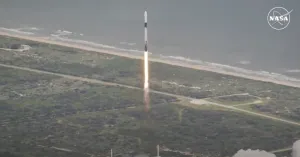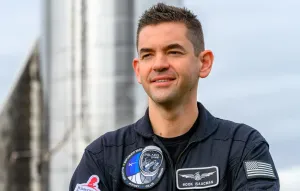
Sep 28, 2024
NASA's Crew-9 mission blasts off!
NASA's SpaceX Crew-9 mission blasted off from Space Launch Complex 40 at 17:17 pm Universal Coordinated Time with Crew Dragon 'Freedom' atop of a Falcon 9 rocket. On board Crew Dragon 'Freedom' are two astronauts, NASA's Nick Hague and Roscosmos' Aleksandr Gorbunov.
Liftoff of Crew-9! pic.twitter.com/laQRTLp4vC
— SpaceX (@SpaceX) September 28, 2024
Liftoff of Crew-9 from Space Launch Complex 40, via SpaceX on X.
Currently, the Crew-9 mission is expected to dock to the International Space Station's Harmony module at approximately 22:30 pm on September 29th. Crew Dragon is currently planned to remain docked at the forward port for approximately 30 days before relocating to the zenith port for the remainder of the mission.
Crew-9 is unlike most operational Commercial Crew Program missions as four crew are not onboard Crew Dragon for launch. This is due to problems with Boeing's Starliner spacecraft during its first human-carrying mission. NASA ruled Starliner too risky to bring Sunita Williams and Butch Wilmore back to Earth. As such Crew-9's Crew Dragon will be bringing the two astronauts back home.
This mission will also be relieving Crew-8 of their duties on board the station ahead of their return to Earth preparations. Crew-8's four crew, Matthew Dominick, Michael Barratt, Jeanette Epps, and Alexander Grebenkin, have been aboard the station since March of this year.
With the current International Space Station schedule Crew-9 will return to Earth in February 2025.
Crew Dragon C212 'Freedom' is supporting this mission and is making its fourth flight. 'Freedom' previously supported the Crew-4, Axiom-2, and Axiom-3 missions.
The booster supporting the launch of Crew-9 was B1085 making its second flight. Following second-stage ignition B1085 headed back to Cape Canaveral to land at Landing Zone 1.
Falcon 9’s first stage booster has landed at Landing Zone 1 pic.twitter.com/UIyD4UoLGn
— SpaceX (@SpaceX) September 28, 2024
Falcon 9 booster B1085 landing at Landing Zone 1, via SpaceX on X.
This was also the first crewed launch from Space Launch Complex 40, as SpaceX completed construction of the crew access tower in late 2023.
NASA's Crew-9 mission is the ninth operational NASA Commercial Crew Program mission to take place and the eleventh carrying humans, including the Crew Dragon Demo-2 mission in 2020 and Starliner's Crewed Flight Test earlier this year.

Who's on board?

Nick Hague is the Commander of the Crew-9 mission for his third trip above the Kármán line, and second to the International Space Station. Hague's first trip into space was during the launch of Soyuz MS-10 which experienced booster failure leading to a high-altitude abort. His first trip to the International Space Station was during the Soyuz MS-12 mission, where he went on to spend 203 days in space as well as conducting three spacewalks.
Aleksandr Gorbunov is a Mission Specialist for the Crew-9 mission for his first trip to space. Gorbunov was selected as a cosmonaut in 2018 having studied engineering at the Moscow Aviation Institute as well as working at Rocket Space Corp. Energia supporting cargo spacecraft launches from the Baikonur Cosmodrome.
What is Crew Dragon?
Crew Dragon, or Dragon 2, is a partially reusable spacecraft developed by SpaceX. The primary use for Crew Dragon is to send crew to and from the International Space Station. SpaceX also performs free-flight missions with the spacecraft.

Crew Dragon consists of the capsule and trunk. The trunk is used to store unpressurized cargo as well as have solar panels mounted on one side, to generate power, and radiators on the other, to dissipate heat generated inside. The trunk is not reused and burns up in the atmosphere after each mission. The capsule is where the crew will be during launch, landing, and while on their way to space.
Unlike the original Dragon capsule, the Crew Dragon capsule has a launch abort system consisting of eight SuperDraco engines. This abort system can also be used to bring the capsule to a soft touchdown in the event of four parachute failures. The capsule also has a nosecone that will fold out of the way in space to protect the docking hardware and forward-facing thrusters during launch and landing. The forward-facing thrusters are the main propulsion system for performing maneuvers while in flight. Up to four parachutes will deploy from the capsule during descent to allow it to splash down for recovery.
Crew Dragon was developed as part of NASA's Commercial Crew Program to regain crew access to the International Space Station from the United States of America after the retirement of the Space Shuttle. SpaceX currently has four active Crew Dragon capsules; Endeavour, Resilience, Endurance, and Freedom. A fifth Crew Dragon capsule is under construction and is expected to be finished in 2024.



